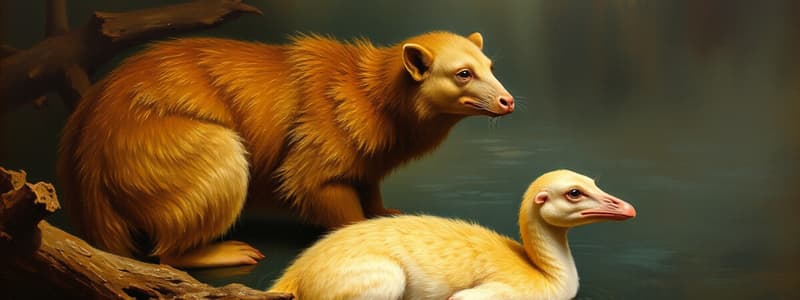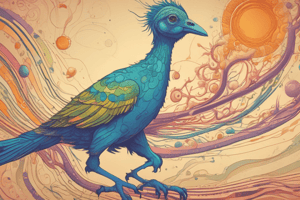Podcast
Questions and Answers
What is an endotherm?
What is an endotherm?
An endotherm is an animal whose body regulates its own temperature by controlling the internal heat it produces.
How do sweating, fur, and feathers affect the body temperatures of endotherms?
How do sweating, fur, and feathers affect the body temperatures of endotherms?
Sweating cools them down when sweat evaporates, while fur and feathers help keep them warm on cool days.
In which of the animals do the females produce milk?
In which of the animals do the females produce milk?
A and C produce milk, because both are mammals.
Is animal B a bird or a mammal? Explain your reasoning.
Is animal B a bird or a mammal? Explain your reasoning.
Using the study guide, decide whether mammal A is a monotreme, a marsupial, or a placental mammal. Explain your reasoning.
Using the study guide, decide whether mammal A is a monotreme, a marsupial, or a placental mammal. Explain your reasoning.
What level of organization is represented by A?
What level of organization is represented by A?
What is the relationship between level A and level B?
What is the relationship between level A and level B?
Identify and define the level of organization represented by structure D.
Identify and define the level of organization represented by structure D.
What is the flexible rod that supports a chordate's back?
What is the flexible rod that supports a chordate's back?
What is the type of worm with many linked sections?
What is the type of worm with many linked sections?
What is an animal that has a backbone called?
What is an animal that has a backbone called?
Which of the following is a characteristic shared by all animals? (Select all that apply)
Which of the following is a characteristic shared by all animals? (Select all that apply)
At some point in their lives, all chordates have a flexible supporting rod in their backs called a?
At some point in their lives, all chordates have a flexible supporting rod in their backs called a?
What does the body temperature of a reptile do when the temperature of the environment changes?
What does the body temperature of a reptile do when the temperature of the environment changes?
Which vertebrate group lays eggs and has feathers?
Which vertebrate group lays eggs and has feathers?
What is radial symmetry?
What is radial symmetry?
What are characteristics of many invertebrate groups?
What are characteristics of many invertebrate groups?
What does it mean to be an ectotherm?
What does it mean to be an ectotherm?
What kind of environment must an animal maintain in their bodies to survive?
What kind of environment must an animal maintain in their bodies to survive?
What group of mammals develop in the mother's pouch?
What group of mammals develop in the mother's pouch?
An ectotherm's body temperature changes depending on the temperature of its?
An ectotherm's body temperature changes depending on the temperature of its?
Classifying animals involves comparing their?
Classifying animals involves comparing their?
An animal may have radial symmetry, bilateral symmetry, or?
An animal may have radial symmetry, bilateral symmetry, or?
Major functions of animals include obtaining food and oxygen, keeping internal conditions stable, movement, and?
Major functions of animals include obtaining food and oxygen, keeping internal conditions stable, movement, and?
Mammals and what are the two groups of vertebrates that are endotherms?
Mammals and what are the two groups of vertebrates that are endotherms?
Most animals are?
Most animals are?
What does the backbone surround and protect in a vertebrate?
What does the backbone surround and protect in a vertebrate?
If only one line can divide an object into mirror-image halves, the object is said to have what kind of symmetry?
If only one line can divide an object into mirror-image halves, the object is said to have what kind of symmetry?
Flashcards are hidden until you start studying
Study Notes
Endotherms and Temperature Regulation
- Endotherms regulate their body temperature through internal heat production.
- Sweating cools endotherms by evaporation, while fur and feathers provide insulation in cooler conditions.
Milk Production in Animals
- Only mammals, identified as A and C, produce milk.
Identifying Birds vs. Mammals
- Animal B is classified as a bird due to its feathers, a characteristic exclusive to birds.
Types of Mammals
- Mammal A is categorized as a monotreme because it lays eggs.
Biological Organization Levels
- Level A represents a cell, while level B represents a tissue, which consists of similar cells performing specific functions.
- Structure D is identified as a system, grouping structures that fulfill broader functions.
Chordate Support Structures
- The notochord is the flexible supporting rod found in chordates.
Segmented Worms
- A segmented worm is characterized by having many linked sections.
Vertebrates
- Vertebrates are defined as animals that possess a backbone.
Common Animal Characteristics
- All animals share characteristics including being multicellular, eukaryotic, and heterotrophic.
Chordate Characteristics
- All chordates possess a notochord at some stage of their lives.
Reptile Temperature Regulation
- The body temperature of reptiles fluctuates with environmental temperature changes.
Egg-Laying Vertebrates
- Birds are the vertebrate group that both lays eggs and has feathers.
Symmetry Types
- Radial symmetry is characterized by having multiple lines of symmetry.
Invertebrate Traits
- Many invertebrate groups are multicellular, lack a backbone, and often have exoskeletons instead of endoskeletons.
Ectotherms
- Ectotherms have bodies that produce minimal internal heat.
Stable Environments for Survival
- Animals must maintain a stable internal environment to survive.
Development of Mammals in Pouches
- Marsupials are the group of mammals that develop in their mother's pouch.
Ectothermic Temperature Dependency
- An ectotherm's body temperature varies based on environmental conditions.
Animal Classification
- Classification of animals involves comparisons of their DNA.
Symmetry Types in Animals
- Animals may exhibit radial symmetry, bilateral symmetry, or asymmetry.
Key Functions of Animals
- Animals obtain food and oxygen, maintain stable internal conditions, exhibit movement, and reproduce as major functions.
Endothermic Vertebrate Groups
- Mammals and birds are the main groups of vertebrates that are endothermic.
Prevalence of Invertebrates
- The majority of animals are classified as invertebrates.
Backbone Functions
- In vertebrates, the backbone surrounds and protects the spinal cord.
Symmetry in Mirror Images
- An object exhibiting bilateral symmetry can only be divided into mirror-image halves by one line.
Studying That Suits You
Use AI to generate personalized quizzes and flashcards to suit your learning preferences.




